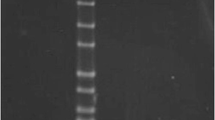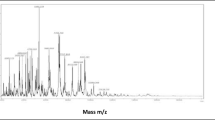Abstract
This study was to assess the emergence of mecA and bla CTX-M in multidrug resistant MRSA/MRSE and ESBL strains in diabetic foot infections. A total of 160 pus samples were collected from the diabetic foot care hospitals, Salem, Tamil Nadu, India. The samples were processed for microbiological investigations and further evaluating the resistant strains. The bacterial strain Staphylococcus aureus was the predominant organisms isolated from the sample. Cefoxitin, Oxacillin and Vancomycin were found to be the most effective antimicrobial agents for therapy of gram positive organisms while Meropenem, Piperacillin, Cefoperazone/Sulbactam, Piperacillin/ Tazobactam and Amikacin were found to be the most effective antimicrobial agents for the gram negative organisms. In this study, four isolates of Methicillin resistant Staphylococcus aureus (MRSA) strains, one isolate of Methicillin resistant Staphylococcus epidermidis (MRSE) and five isolates of Pseudomonas aeruginosa were found to be extended spectrum of β - lactamase (ESBL) producers by phenotypic method. These strains subjected to genotypic confirmation confirmed the presence of resistant genes namely bla CTX-M in ESBL and SCC mecA in Staphylococcus spp. The 16S rRNA partial gene sequencing and phylogenetic analysis of the multi drug resistant organisms Pseudomonas aeruginosa (APS01) and Staphylococcus epidermidis (APS02) was confirmed the resistant pattern in these strains. The resistant organism was eradicated only by the effective management of this infection; knowledge on the causative agent causing cruel diabetic foot infections will be very useful in selecting the appropriate therapy.






Similar content being viewed by others
References
Abd Hamead Hefni A, Metwally R, Ibrahim Khaled M, Attia Mahmoud M, Moawad Ayman F, Eramah Mohamed M, et al. Bacteriological study of diabetic foot infection in Egypt. J Arab Soc Med Res. 2013;8:26–32.
Edward Boyko J, Jessie Ahroni H, Stensel V, Ruby Forsberg C, Denise Davignon R, Douglas Smith G. A prospective study of risk factors for diabetic foot ulcer. Diabetes Care. 1999;22(7):1036–42.
Mendes JJ, Marques Costa A, Vilela C, Neves J, Candeias N, Cavaco Silva P, et al. Clinical and bacteriological survey of diabetic foot infections in Lisbon. Diab Res Clin Pract. 2012;95:153–61.
Bonnet R. Growing group of extended-spectrum b-lactamases: the CTX-M enzymes. Antimicrob Agents Chemother. 2004;48:1–14.
Gadepalli R, Dhawan B, Sreenivas V, Kapil A, Ammini AC, Chaudhry R. A clinico-microbiological study of diabetic foot ulcers in an Indian tertiary care hospital. Diabetes Care. 2006;29:1727–32.
Mathur T, Singhal S, Khan S, Upadhyay DJ, Fatma T, Rattan A. Detection of biofilm formation among the clinical isolates of Staphylococci: an evaluation of three different screening methods. Indian J Med Microbiol. 2006;24:25–9.
Zubair M, Malik A, Ahmad J. Study of plasmid mediated extended spectrum beta lactamase producing strains of Enterobacteriaceae, isolated from foot infections in north Indian tertiary care hospital. Diabetes Technol Therap. 2012;12(4):315–24.
John Holt G. Bergey’s Manual of Determinative Bacteriology. 9th Edition. United States of America; 2000.
Clinical Laboratory Standards Institute (CLSI). Performance standards for antimicrobial susceptibility testing. 11th Edition. 2012; 32: 1.
Sambrook, Russell. Molecular cloning - a laboratory manual. 3rd ed. Newyork: Cold spring harbor laboratory press; 2001.
Leela Rani K, Madhumathi, Belwadi S, Ramana BV. Bacteriological profile of diabetic foot ulcer. Int J Pharma Res Bio. 2013;2(2):36–45.
Dhanasekaran G, Sastry G, Viswanathan M. Microbial pattern of soft tissue infections in diabetic patients in South India. Asian J Diabet. 2003;5:8–10.
Tiwari S, Pratyush DD, Dwivedi A, Gupta SK, et al. Microbiological and clinical characteristics of diabetic foot infections in northern India. J Infect Dev Ctries. 2012;6(4):329–32.
Abdulrazak A, Bitar ZI, Al-Shamali AA, Mobasher LA. Bacteriological study of diabetic foot infections. J Diab Complicat. 2005;19:138–41.
Sharma VK, Khakda PB, Joshi A, Sharma R. The common pathogens which were isolated from diabetic foot infections in Bir hospital. Kathmandu Univ Med J. 2006;4(3):295–301.
Rajalakshmi V, Amsaveni V. Antibiotic susceptibility of bacterial pathogens isolated from diabetic patients. Int J Microbio Res. 2012;3(1):30–2.
Lipsky BA. Empirical therapy for diabetic foot infections: are there clinical clues to guide antibiotic selection. Clin Microbiol Infect. 2007;13:351–3.
Citron DM, Goldstein EJC, Merriam CV, Lipsky BA, Abraham MA. Bacteriology of the moderate to severe diabetic foot infections and the in vitro activity of the antimicrobial agents. J Clin Microbiol. 2007;45(9):2819–28.
Zubair M, Malik A, Ahmadb J. The impact of creatinine clearance on the outcome of diabetic foot ulcers in north Indian tertiary care hospital. Diabetes Met Syn: Clin Res Rev. 2011;5:120–5.
Zhang K, McClure JA, Elsayed S, Conly JM. Novel staphylococcal cassette chromosome mec type, tentatively designated type VIII, harboring class a mec and type 4 ccr gene complexes in a canadian epidemic strain of Methicillin resistant Staphylococcus aureus. Antimicrob Agents Chemother. 2009;53(2):531–40.
Miragaia M, Couto I, Pereira SF, Kristinsson KG, Westh H, Jarlov JO, Carrico J, Almeida J, Santos Sanches I, De Lencastre H. Molecular characterization of Methicillin resistant Staphylococcus epidermidis clones: evidence of geographic dissemination. J Clin Microbiol. 2002;40:430–8.
Duarte Oliveira C, de Lencastre H. Multiplex PCR strategy for rapid identification of structural types and variants of the mec element in Methicillin-resistant Staphylococcus aureus. Antimicrob Agents Chemother. 2002;46(7):2155–61.
Pitout JDD, Nordmann P, Laupland KB, Poirel L. Emergence of enterobacteriaceae producing extended-spectrum beta lactamases (ESBLs) in the community. J Antimicrobiol Chemother. 2005;56:52–9.
Nashwan al Naiemi, Birgitta Duim, Aldert Bart. A CTX-M extended spectrum beta lactamases in Pseudomonas aeruginosa and Stenotrophomonas maltophilia. J Med Microbiol. 55: 1607–1608.
Polotto M, Casella T, de Lucca Oliveira MG, Rubio FG, Mauricio L, et al. Detection of P.aeruginosa harboring bla CTX-M-2 , bla GES-1 and bla GES-5 , bla IMP-1 and bla SPM-1 causing infections in brazilian tertiary care hospital. BMC Infect Dis. 2012;12:176.
Farshadzadeh Z, Khosravi AD, Alavi SM, Parhizgari N, Hoveizavi H. Spread of extended-spectrum β-lactamase genes of bla OXA-10 , bla PER-1 and bla CTX-M in Pseudomonas aeruginosa strains isolated from burn patients. Burns. 2014;40(8):1575–80.
Relman DA, Schmidt TM, Mac Dermott RP, Falkow S. Identification of the uncultured bacillus of Whipple’s disease. N Engl J Med. 1992;327:293–301.
Santos Sanches I, Mato R, de Lencastre H, Tomasz A, Nunes S, Alves CR, et al. Patterns of multidrug resistance among Methicillin-resistant hospital isolates of coagulase positive and coagulase negative Staphylococci collected in the international multicenter study resist in 1997 and 1998. Microb Drug Res. 2000;6:199–211.
Otto M. Staphylococcus epidermidis - the accidental pathogen. Nat Rev Microbiol. 2009;7:555–67.
Kandemir O, Akbay Sahin E, Millan A, Gen R. Risk factor for infection of the diabetic foot with multi-antibiotic resistant microorganisms. J Inf Secur. 2007;54:439–45.
Author information
Authors and Affiliations
Corresponding author
Ethics declarations
Funding
None.
Conflict of interest
P. Sugandhi declares that she has no conflict of interest. D. Arvind Prasanth declares that he has no conflict of interest.
Ethical approval
All procedures performed in studies involving human participants were in accordance with the ethical standards of the institutional research committee and with the 1964 Helsinki declaration and its later amendments or comparable ethical standards.
Informed consent
Informed consent was obtained from all individual participants included in the study.
Rights and permissions
About this article
Cite this article
Sugandhi, P., Prasanth, D.A. Emergence of multi drug resistance strains causing diabetic foot infection in Salem, Tamil Nadu, India. Int J Diabetes Dev Ctries 38, 100–107 (2018). https://doi.org/10.1007/s13410-017-0555-4
Received:
Accepted:
Published:
Issue Date:
DOI: https://doi.org/10.1007/s13410-017-0555-4




